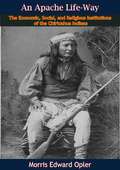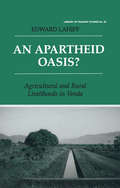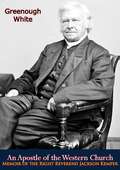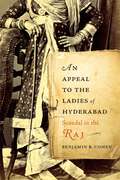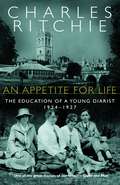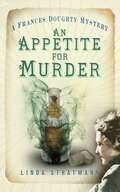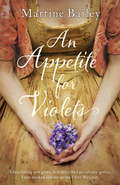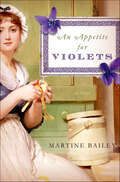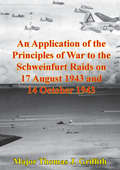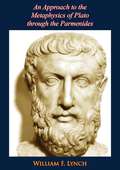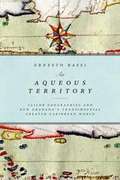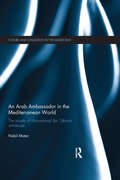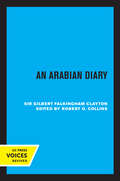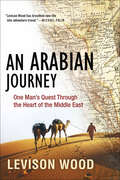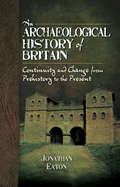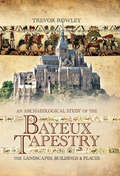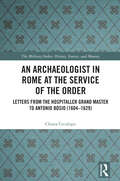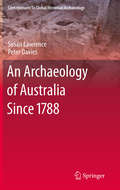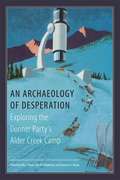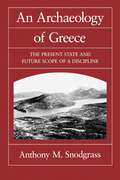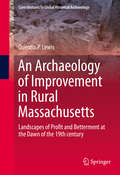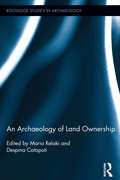- Table View
- List View
An Anzac on the Western Front: The Personal Reflections of an Australian Infantryman from 1916 to 1918
by H.R. Williams&“A remarkably candid and graphic account&” of the World War I service of a member of the Australian and New Zealand Army Corps (Britain at War Magazine). Having enlisted in 1915 and serving in the 56th Battalion Australian Imperial Force, Harold Roy Williams arrived in France, from Egypt, on June 30, 1916. He describes the horrors of the Fromelles battlefield in shocking clarity and the conditions the troops had to endure are revealed in disturbing detail. Surviving a later gas attack, Harold Williams&’s subsequent postings read like a tour of the Western Front. Following the Somme, there was the mud and squalor of the line south of Ypres, the German Spring Offensive of 1918, the Battle of Amiens—frequently described as the most decisive battle against the Germans in France and Flanders—the capture of Villers-Bretonneux and, finally, the assault on Péronne. Injured at Péronne and invalided back to the United Kingdom, Williams survived the war to return to Australia in 1919. An Anzac on the Western Front is his vivid description of his service in the First World War—an account that was described as &“the best soldier&’s story . . . yet read in Australia&” when it was first published. &“Williams&’ experience was defined by his rise from private soldier to platoon commander and he confined his writing to it. This is a story of cold, hunger, injury, fear, humour, friendship and death . . . So bloody good.&” —War History Online
An Apache Campaign in the Sierra Madre: an Account of the Expedition in Pursuit of the Chiricahua Apaches in Arizona, 1883
by John G Bourke“With Crook in pursuit of Geronimo and his band.The author of this book was a U.S. soldier in addition to being a well known and highly regarded author on the Apache Wars of the later nineteenth century-in which he was an active participant. He maintained an interest, respect for and in some measure an affection for the Apaches and he also made a serious study of and wrote notable works on their customs and culture. He is perhaps best known for his classic account of the Apache Wars, 'On the Border with Crook.' This small account was written prior to his larger and more expansive work. It originally appeared as a series of articles in the Boston published 'Outing Magazine.' Bourke decided to bring his earlier writings back into print in book form, at a time when the Apaches had once again taken the war trail, to provide the American public with context to then current events. This fascinating account, which centres on the events of the Spring of 1883, concerns Crook's pursuit of the Chiricahua Apaches who broke out of San Carlos reservation to raid through Arizona and Mexico before vanishing into the fastness of the Sierra Madre. Those with any interest or knowledge in this subject will find themselves familiarly introduced to the corps of Apache Scouts, Al Sieber (Zieber), the scout and interpreter, Crook, Gatewood, Chato and of course the renowned Geronimo, as well as other names long associated with this remarkable time in the history of the Apaches and Arizona.”-Print ed.
An Apache Life-Way: The Economic, Social, and Religious Institutions of the Chiricahua Indians
by Morris Edward OplerA majority of ethnographer Morris Edward Opler’s research was done on Native American groups of the American Southwest. He studied specifically the Chiricahua Indians, who were the subjects of one of his most famous books, An Apache Life-Way: The Economic, Social, and Religious Institutions of the Chiricahua Indians. Opler studied many Native American groups, but the Apache were a main focus of his.An Apache Life-Way traces the life of an Apache year by year. Rather than a history, the book explains the day-to-day Apache experience, detailing the chronological order of one’s life. The lifestyle described in the book is from a time before the Americans started the long era of hostile interactions with the Apache.The people designated as “Apache” in this book are those who spoke the Apache language in the area that is now New Mexico, Arizona, Sonora, and Chihuahua. There were many smaller sub-groups that populated these areas, three of them different groups of the Chiricahua Apache.An Apache Life-Way is divided into several main parts: Childhood; Maturation; Social Relations of Adults; Folk Beliefs, Medical Practice, and Shamanism; Maintenance of the Household; Marital and Sexual Life; The Round of Life; Political Organization and Status; and Death, Mourning, and the Underworld. Each section is divided into more specific subcategories that explore each phase of life and the rituals associated with it.Originally published in 1941, An Apache Life-Way remains one of the most important and innovative studies of south-western Native Americans.“First-class...in the best ethnographic tradition. It fills a great gap in our anthropological knowledge and...deserves to be one of the most used of American tribal records.”—Ruth Benedict, author of Patterns of Culture
An Apartheid Oasis?: Agriculture and Rural Livelihoods in Venda
by Edward LahiffThis is a socio-economic study of agriculture and its contribution to livelihoods in Venda, one of the black "homelands" created in South Africa under apartheid. It is based on a survey of households in the Tshiombo irrigation scheme, a project in central Venda with around 600 plot-holders.
An Apostle of the Western Church: Memoir of the Right Reverend Jackson Kemper
by Greenough WhiteBishop (David) Jackson Kemper (1789-1870) was the first missionary bishop of the Episcopal Church in the United States of America. He was made a deacon of the Episcopal Church in 1811 and was ordained as a priest in 1814. In 1835, the Episcopal Church undertook to consecrate missionary bishops to preach the Gospel west of the settled areas, and Kemper was the first to be chosen. He promptly headed west. Having found that clergy who had lived all their lives in the settled East were slow to respond to his call to join him on the frontier, he determined to recruit priests from among men who were already in the West, and established a college in St. Louis, Missouri, for that purpose. He went on to found Nashotah House and Racine College in Wisconsin, and founded the mission parish that became the Cathedral Church of All Saints in Milwaukee. He constantly urged a more extensive outreach to the Native American peoples, and translations of the Scriptures and the services of the Church into their languages. From 1859 till his death in 1870, he was bishop of Wisconsin.-Print ed.
An Appeal to the Ladies of Hyderabad: Scandal in the Raj
by Benjamin B. CohenBenjamin Cohen tells the dramatic story of Mehdi Hasan and Ellen Donnelly, whose marriage convulsed high society in nineteenth-century India and whose notorious trial reverberated throughout the British Empire, setting the benchmark for Victorian scandals. In the struggle of one couple, he exposes the fault lines that would soon tear a world apart.
An Appetite for Life: The Education of a Young Diarist, 1924-1927
by Charles RitchieCharles Ritchie's first volume of diaries, The Siren Years, created a sensation when it was published in 1974. Besides winning the Governor General's Award for Non-fiction, it was hailed by reviewers on both sides of the Atlantic. An Appetite for Life, his second volume, first published in 1977, deals with his youth in Halifax and his career at Oxford - the years when Charles Ritchie turned from a callow, blundering youth into a callow, blundering young man.As these diaries show, Charles Ritchie had a sharp eye, a keen ear, a highly developed sense of the absurd, and - despite his unhappy knack of landing ?at on his face - a thorough "appetite for life." This is not only a hilariously funny book, but it presents a vivid picture of two worlds - Halifax and Oxford in the mid-twenties - that are now long gone. It also introduces us to an astonishing range of characters, but the most astonishing of all is the young Charles Ritchie himself.From the Trade Paperback edition.
An Appetite for Murder: A Frances Doughty Mystery 4
by Linda StratmannThe sudden death of overweight 49-year-old Thomas Whibley sparks off an acrimonious furore in Bayswater, and sparks fly between rival diet doctors, vegetarians and the extremist Pure Food Society. Young sleuth Frances Doughty is engaged to discover the author of anonymous libels, when a former colleague of Whibley’s, Hubert Sweetman, who has served fourteen years in prison for a violent robbery he claims he did not commit, asks her to trace his estranged family. Before she can start, however, the police arrive and arrest her client for the murder of his wife. There will be more murders and a vicious attack on Frances before she finally resolves a number of knotty questions. Is Hubert Sweetman really innocent? Where are his missing children? And who wielded the poisoned pen? The fourth book in the popular Frances Doughty Mystery series.
An Appetite for Violets
by Martine BaileyThat's how it is for us servants. No one pays you much heed; mostly you're invisible as furniture. Yet you overhear a conversation here, and add a little gossip there. A writing desk lies open and you cannot help but read a paper. Then you find something, something you should not have found.Irrepressible Biddy Leigh, under-cook at the foreboding Mawton Hall, only wants to marry her childhood sweetheart and set up her own tavern. But when her elderly master marries the young Lady Carinna, Biddy is unwittingly swept up in a world of scheming, secrets and lies.Forced to accompany her new mistress to Italy, Biddy takes with her an old household book of recipes, The Cook's Jewel, in which she records her observations. When she finds herself embroiled in a murderous conspiracy, Biddy realises that the secrets she holds could be the key to her survival - or her downfall . . .
An Appetite for Violets: A Novel
by Martine BaileyThat's how it is for us servants. No one pays you much heed; mostly you're invisible as furniture. Yet you overhear a conversation here, and add a little gossip there. A writing desk lies open and you cannot help but read a paper. Then you find something, something you should not have found.Irrepressible Biddy Leigh, under-cook at the foreboding Mawton Hall, only wants to marry her childhood sweetheart and set up her own tavern. But when her elderly master marries the young Lady Carinna, Biddy is unwittingly swept up in a world of scheming, secrets and lies.Forced to accompany her new mistress to Italy, Biddy takes with her an old household book of recipes, The Cook's Jewel, in which she records her observations. When she finds herself embroiled in a murderous conspiracy, Biddy realises that the secrets she holds could be the key to her survival - or her downfall . . .
An Appetite for Violets: A Novel
by Martine Bailey"That's how it is for us servants. No one pays you much heed; mostly you're invisible as furniture. Yet you overhear a conversation here, and add a little gossip there. Then you find something, something you should not have found."Irrepressible Biddy Leigh, under-cook at forbidding Mawton Hall, only wants to marry her childhood sweetheart and set up her own tavern. But when her elderly master marries young Lady Carinna, Biddy is unwittingly swept up in a world of scheming, secrets, and lies. Forced to accompany her new mistress to Italy, she documents her adventures and culinary discoveries in an old household book of recipes, The Cook's Jewel. Biddy grows intrigued by her fellow travelers, but her secretive and unconventional mistress is the most intriguing of all.In London, Biddy finds herself attracted to her mistress's younger brother. In France, she discovers her mistress's dark secret. At last in Italy, Biddy becomes embroiled in a murderous conspiracy, knowing the secrets she holds could be a key to a better life, or her downfall.Inspired by eighteenth-century household books of recipes and set at the time of the invention of the first restaurants, An Appetite for Violets is a literary feast for lovers of historical fiction. Martine Bailey's novel opens a window into the fascinating lives of servants, while also delivering a suspenseful tale of obsession and betrayal.
An Application Of The Principles Of War To The Schweinfurt Raids On 17 August 1943 And 14 October 1943
by Major Thomas J. GriffithThis monograph provides a historical look at the use of daylight precision bombing by American bombers against the ball-bearing factories at Schweinfurt, Germany, on 17 August 1943 and 14 October 1943. The principles of war from AFM 1-1, Basic Aerospace Doctrine of the United States Air Force, are used to analyze the strengths and weaknesses of the American and German efforts during these operations.
An Approach to the Metaphysics of Plato through the Parmenides
by William F. LynchA provocative and original interpretation of the Parmenides as constructive, positive metaphysics. By bringing together the speculative enthusiasm of the continental tradition with the more patient analysis of English scholarship Lynch has opened up a new line of inquiry and discussion.--R. S. B.in Review of Review of Metaphysics 13
An Aqueous Territory: Sailor Geographies and New Granada's Transimperial Greater Caribbean World
by Ernesto BassiIn An Aqueous Territory Ernesto Bassi traces the configuration of a geographic space he calls the transimperial Greater Caribbean between 1760 and 1860. Focusing on the Caribbean coast of New Granada (present-day Colombia), Bassi shows that the region's residents did not live their lives bounded by geopolitical borders. Rather, the cross-border activities of sailors, traders, revolutionaries, indigenous peoples, and others reflected their perceptions of the Caribbean as a transimperial space where trade, information, and people circulated, both conforming to and in defiance of imperial regulations. Bassi demonstrates that the islands, continental coasts, and open waters of the transimperial Greater Caribbean constituted a space that was simultaneously Spanish, British, French, Dutch, Danish, Anglo-American, African, and indigenous. Exploring the "lived geographies" of the region's dwellers, Bassi challenges preconceived notions of the existence of discrete imperial spheres and the inevitable emergence of independent nation-states while providing insights into how people envision their own futures and make sense of their place in the world.
An Arab Ambassador in the Mediterranean World: The Travels of Muhammad ibn ‘Uthmān al-Miknāsī, 1779-1788 (Culture and Civilization in the Middle East)
by Nabil MatarThis book provides translated selections from the writings of Muhammad Ibn Othman al-Miknasi (d. 1799). The only writings by an Arab-Muslim in the pre-modern period that present a comparative perspective, his travelogues provide unique insight with in to Christendom and Islam. Translating excerpts from his three travelogues, this book tells the story of al-Miknasi’s travels from 1779-1788. As an ambassador, al-Miknasi was privy to court life, government offices and religious buildings, and he provides detailed accounts of cities, people, customs, ransom negotiations, historical events and political institutions. Including descriptions of Europeans, Arabs, Turks, Christians (both European and Eastern), Muslims, Jews, and (American) Indians in the last quarter of the eighteenth century, An Arab Ambassador in the Mediterranean World explores how the most travelled Muslim writer of the pre-modern period saw the world: from Spain to Arabia and from Morocco to Turkey, with second-hand information about the New World. Supplemented with extensive notes detailing the historic and political relevance of the translations, this book is of interest to researchers and scholars of Mediterranean History, Ottoman Studies and Muslim-Christian relations.
An Arabian Diary
by Sir Gilbert ClyatonThis personal diary of six months of diplomacy and travel in Arabia represents and impressive document to the quiet ability and resourcefulness of one of Great Britain's leading officials in the Middle East in the 1920's. The sudden expansion of the Arabian Sultanate of Najd under the leadership of 'Abd-al-'Aziz ibn Sa'ud after the First World War presented a clear danger to British interests in the Middle East and threatened the strategically important Arabian corridor to India. To resolve this project the British government selected Sir Gilbert Clayton as their envoy to negotiate a settlement of differences and to determine the frontier between Saudi Arabia and the British Mandates of Trans-Jordan and Iraq. Sir Gilbert Falkingham Clayton (1875-1929) was a quiet, able soldier, administrator, and diplomat who had come out to eh Middle East during the reconquest of the Sudan and remained as a political officer in theSudan service, secretary to the Governor-General of the Sudan, Sir Reginald Wingate, and finally the Sudan agent at Cairo. At the outbreak of the First World War, Clayton served as the director of Military Intelligence an forged that remarkable intelligence team which included among others Leonard Woolley, George Lloyd, and T.E. Lawrence. Experience and resourceful, Clayton was an obvious choice to travel to the tents of Iban Sa'ud where the autumn of 1925 he negotiated the Bahra and Hadda Agreements fixing the frontiers of Saudi Arabia with Trans-Jordan and Iraq and cementing friendship between Britain and Ibn Sa'ud. These results represent a brilliant triumph of personal diplomacy which protected British interests and inaugurated the lifelong friendship between Sir Gilbert and Ibn Sa'ud. The story of these negotiations and Sir Gilbert's subsequent mission to the Imam of Yemen as the first official representative of the British government to visit San'a' are told in this valuable historical diary. This title is part of UC Press's Voices Revived program, which commemorates University of California Press's mission to seek out and cultivate the brightest minds and give them voice, reach, and impact. Drawing on a backlist dating to 1893, Voices Revived makes high-quality, peer-reviewed scholarship accessible once again using print-on-demand technology. This title was originally published in 1969.
An Arabian Journey: One Man's Quest Through the Heart of the Middle East
by Levison WoodThe acclaimed author of Walking the Americas shares his epic journey through the war-torn Arabian Peninsula in this fascinating travelogue.Following in the footsteps of famed explorers such as Lawrence of Arabia and Wilfred Thesiger, British explorer Levison Wood brings us along on his most complex expedition yet: a circumnavigation of the Arabian Peninsula. Starting in September 2017 in a city in Northern Syria, a stone’s throw away from Turkey and amidst a deadly war, Wood set forth on a 5,000-mile trek through the most contested region on the planet.Wood moved through the Middle East for six months, from ISIS-occupied Iraq through Kuwait and along the jagged coastlines of the Emirates and Oman; across Yemen—in the midst of civil war—and on to Saudia Arabia, Jordan, and Israel, before ending on the shores of the Mediterranean in Lebanon. Like his predecessors, Wood travelled through some of the harshest and most beautiful environments on earth, seeking to challenge our perceptions of this part of the world. Through the people he meets—and the personal histories and local mythologies they share—Wood examines how the region has changed over thousands of years and what it means to its people today.
An Archaeological History of Britain: Continuity and Change from Prehistory to the Present
by Jonathan EatonThis authoritative and accessible volume presents an archeological of Britain across millennia, from early prehistory to the present. The Archaeological History of Britain takes us from the earliest prehistoric archaeology right up to the contemporary archaeology of the present day through the use of key sites. Historian Jonathan Eaton uses key sites to illustrate each significant time period along with a narrative of change to accompany the changing archaeological record. The wide range of evidence utilized by archaeologists, such as artefacts, landscape studies, historical sources and genetics are emphasized throughout this chronological journey. The latest theoretical advances and practical discoveries are also explored, making this the most advanced narrative of British archaeology available.
An Archaeological Study of the Bayeux Tapestry: The Landscapes, Buildings and Places
by Trevor RowleyAn analysis of the famed medieval English tapestry through examination of the depicted landscapes, towns, castles, and other structures.An Archaeological Study of the Bayeux Tapestry provides a unique re-examination of this famous piece of work through the historical geography and archaeology of the tapestry. Trevor Rowley is the first author to have analyzed the tapestry through the landscapes, buildings and structures shown, such as towns and castles, while comparing them to the landscapes, buildings, ruins and earthworks which can be seen today. By comparing illustrated extracts from the tapestry to historical and contemporary illustrations, maps and reconstructions Rowley is able to provide the reader with a unique visual setting against which they are able to place the events on the tapestry. This approach allows Rowley to challenge a number of generally accepted assumptions regarding the location of several scenes in the tapestry, most controversially suggesting that William may never have gone to Hastings at all. Finally, Rowley tackles the missing end of the tapestry, suggesting the places and events which would have been depicted on this portion of William&’s journey to Westminster.Praise forAn Archaeological Study of the Bayeux Tapestry &“We all know what the Bayeux Tapestry celebrates in its iconic artwork, but Trevor Rowley goes one step further and looks at the buildings and characters with a view actually identifying them! Absolutely fascinating, brings a whole new dimension to the study of this amazing artefact.&” —Books Monthly &“Rowley&’s arguments are copiously illustrated with details from the tapestry, photographs and plans. It results in very densely packed chapters well worth reading, and you certainly will never look at that tea towel in the same way again.&” —Hexham Local History Society
An Archaeologist in Rome at the Service of the Order: Letters from the Hospitaller Grand Master to Antonio Bosio (1604–1629) (The Military Religious Orders)
by Chiara CecalupoAn Archaeologist in Rome at the Service of the Order presents the so-far completely unknown letters between the Grand Masters (Alof de Wignacourt, Luís Mendes de Vasconcellos and Antoine de Paule) and Antonio Bosio, who is well known worldwide for his extensive discoveries of the Roman Christian catacombs and was also an Agent of the Order of Malta in Rome. The letters were sent between 1604 and 1629 and are currently held at the National Library of Malta.After a complete account on Bosio’s biography and family history, the letters are transcribed, translated and commented, in order to open a window on the role of the Agent in Rome in the very early seventeenth century, a particular juncture in the Order’s history, and on the relations between Malta and Rome.The study and publication of these materials make it possible to present Antonio Bosio’s political and administrative works at the service of the Grand Master to the international public and academics interested in the history of the Order.
An Archaeology of Australia Since 1788 (Contributions To Global Historical Archaeology)
by Peter Davies Susan LawrenceThis volume provides an important new synthesis of archaeological work carried out in Australia on the post-contact period. It draws on dozens of case studies from a wide geographical and temporal span to explore the daily life of Australians in settings such as convict stations, goldfields, whalers' camps, farms, pastoral estates and urban neighbourhoods. The different conditions experienced by various groups of people are described in detail, including rich and poor, convicts and their superiors, Aboriginal people, women, children, and migrant groups. The social themes of gender, class, ethnicity, status and identity inform every chapter, demonstrating that these are vital parts of human experience, and cannot be separated from archaeologies of industry, urbanization and culture contact. The book engages with a wide range of contemporary discussions and debates within Australian history and the international discipline of historical archaeology. The colonization of Australia was part of the international expansion of European hegemony in the eighteenth and nineteenth century. The material discussed here is thus fundamentally part of the global processes of colonization and the creation of settler societies, the industrial revolution, the development of mass consumer culture, and the emergence of national identities. Drawing out these themes and integrating them with the analysis of archaeological materials highlights the vital relevance of archaeology in modern society.
An Archaeology of Desperation: Exploring The Donner Party's Alder Creek Camp
by Julie M. Schablitsky Kelly J. Dixon Shannon A. NovakThe Donner Party is almost inextricably linked with cannibalism. In truth, we know remarkably little about what actually happened to the starving travelers stranded in the Sierra Nevada in the winter of 1846-47. Combining the approaches of history, ethnohistory, archaeology, bioarchaeology, and social anthropology, this innovative look at the Donner Party's experience at the Alder Creek Camp offers insights into many long-unsolved mysteries. Centered on archaeological investigations in the summers of 2003 and 2004 near Truckee, California, the book includes detailed analyses of artifacts and bones that suggest what life was like in this survival camp. Microscopic investigations of tiny bone fragments reveal butchery scars and microstructure that illuminate what the Donner families may have eaten before the final days of desperation, how they prepared what served as food, and whether they actually butchered and ate their deceased companions. The contributors reassess old data with new analytic techniques and, by examining both physical evidence and oral testimony from observers and survivors, add new dimensions to the historical narrative. The authors' integration of a variety of approaches - including narratives of the Washoe Indians who observed the Donner Party - destroys some myths, deconstructs much of the folklore about the stranded party, and demonstrates that novel approaches can shed new light on events we thought we understood.
An Archaeology of Greece: The Present State and Future Scope of a Discipline (Sather Classical Lectures #53)
by Anthony M. SnodgrassClassical archaeology probably enjoys a wider appeal than any other branch of classical or archaeological studies. As an intellectual and academic discipline, however, its esteem has not matched its popularity. Here, Anthony Snodgrass argues that classical archaeology has a rare potential in the whole field of the study of the past to make innovative discoveries and apply modern approaches by widening the aims of the discipline.
An Archaeology of Improvement in Rural Massachusetts: Landscapes of Profit and Betterment at the Dawn of the 19th century (Contributions To Global Historical Archaeology)
by Quentin LewisThis book probes the materiality of Improvement in early 19th century rural Massachusetts. Improvement was a metaphor for human intervention in the dramatic changes taking place to the English speaking world in the 18th and 19th centuries as part of a transition to industrial capitalism. The meaning of Improvement vacillated between ideas of economic profit and human betterment, but in practice, Improvement relied on a broad assemblage of material things and spaces for coherence and enaction. Utilizing archaeological data from the home of a wealthy farmer in rural Western Massachusetts, as well as an analysis of early Republican agricultural publications, this book shows how Improvement's twin meanings of profit and betterment unfolded unevenly across early 19th century New England. The Improvement movement in Massachusetts emerged at a time of great social instability, and served to ameliorate growing tensions between urban and rural socioeconomic life through a rationalization of space. Alongside this rationalization, Improvement also served to reshape rural landscapes in keeping with the social and economic processes of a modernizing global capitalism. But the contradictions inherent in such processes spurred and buttressed wealth inequality, ecological distress, and social dislocation.
An Archaeology of Land Ownership (Routledge Studies in Archaeology #9)
by Maria Relaki Despina CatapotiWithin archaeological studies, land tenure has been mainly studied from the viewpoint of ownership. A host of studies has argued about land ownership on the basis of the simple co-existence of artefacts on the landscape; other studies have tended to extrapolate land ownership from more indirect means. Particularly noteworthy is the tendency to portray land ownership as the driving force behind the emergence of social complexity, a primordial ingredient in the processes that led to the political and economic expansion of prehistoric societies. The association between people and land in all of these interpretive schemata is however less easy to detect analytically. Although various rubrics have been employed to identify such a connection – most notable among them the concepts of ‘cultures,’ ‘regions,’ or even ‘households’ – they take the links between land and people as a given and not as something that needs to be conceptually defined and empirically substantiated. An Archaeology of Land Ownership demonstrates that the relationship between people and land in the past is first and foremost an analytical issue, and one that calls for clarification not only at the level of definition, but also methodological applicability. Bringing together an international roster of specialists, the essays in this volume call attention to the processes by which links to land are established, the various forms that such links take and how they can change through time, as well as their importance in helping to forge or dilute an understanding of community at various circumstances.


